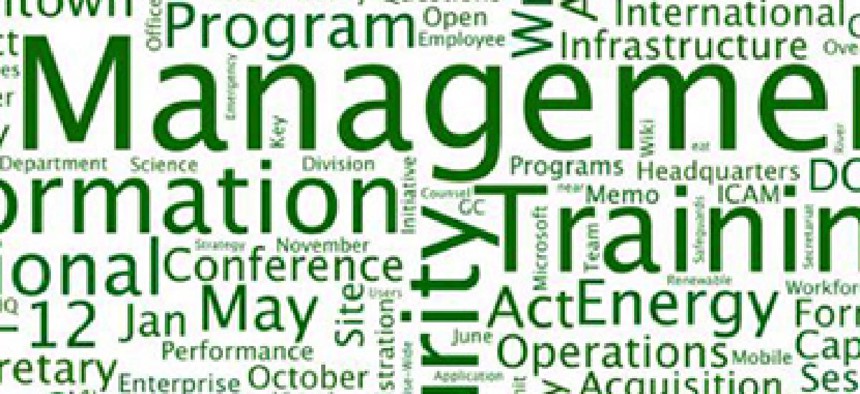Agencies getting better at social tools

A new report documents some successful social-media programs, offers advice for agencies.

This word cloud shows the most popular topics on Powerpedia, the Energy Department's internal wiki. (Source: Energy Department)
There is no shortage of social activity in government, but a new report finds that agencies are becoming increasingly familiar with the benefits of social platforms and discovering uses that further their missions.
The Partnership for Public Service and Booz Allen Hamilton’s new study looks at how agencies use technology and social media. In interviews with 26 individuals from 12 agencies and offices, the report authors identified use cases involving Facebook, Skype, mobile applications, wikis, crowdsourcing and other social tools to support and enhance goals and missions.
One of the social success stories came from the State Department. Its app for teaching English at the intermediate level in Tunisia saw “an incredible adoption,” said Suzanne Philion, senior adviser for innovation at State’s Bureau of Educational and Cultural Affairs, who spoke at the Jan. 9 panel where the report was released.
By the time the 90-day pilot program ended, it had 535,000 users in a nation where 6 million people have mobile devices, she said. As a public diplomacy effort, Philion said, this particular initiative turned out to be an excellent proof of concept for the agency. The mobile apps and technology gave the agency the ability to reach out to individuals with whom it normally does not have a lot of connection, she said.
The Energy Department’s internal wiki, Powerpedia, also has seen successful implementation. Launched in 2009, the collaborative resource now boasts 15,000 distinct pages and as many as 700 edits a day. In total, it has had more than 100,000 edits and 1 million page views.
Powerpedia exemplifies how one of the largest and the most decentralized agency can bring together remote offices and employees to collaborate, said Chris Thompson, director of research and policy at the Partnership for Public Service, who moderated the Jan. 9 panel.
The effort also showed how social media can cut across silos in organizations, Thompson said, adding light-heartedly: “and there are a few silos still in federal agencies – I’m not looking at anyone in particular here.”
These case studies, outlined in the report along with other examples, suggest an overall move to embrace social platforms, the presenters said. However, social media are still far from ubiquitous across government, the report pointed out, and misconceptions about social platforms still permeate agencies.
“One of the biggest things I learned when I came on board in government was that people in government really didn’t believe that anyone cared about what they were doing,” said Tammi Marcoullier, team lead of engagement and outreach at the Office of Citizen Services and Innovative Strategies at the General Services Administration.
“Once they got over that hurdle, they found that getting out there and talking to people, people did really care and wanted to give feedback and participate and be involved,” she said.
People are “crazy passionate” about a variety of causes, from the U.S. Geological Survey to the Census Bureau, she said. They want to know what is happening in their communities, in government and their area of interest, Marcoullier stressed.
But to ensure the success of a social media effort, it must be tied directly to program missions and goals. Agencies need to know exactly how various social media will be used to support mission outcomes. They need to understand which social media platforms are appropriate for their specific needs, and how to accurately track the tool’s success.
Agencies also need to be aware of the pros and cons of social media -- to know their capacity and role. Social platforms are far from a panacea and “will not miraculously fix an organization’s communication, budget, performance or management issues,” the report stressed.
“Pilot, start small, take your metrics and it isn’t just about the number of people who are viewing or clicking and looking," Marcoullier said. "It’s about what happens when they get that information shared with them – are they doing something different?”
But, she said, don’t try to bypass the opportunity. “Everyone should touch social media,” she said.
The social media revolution is already in its 10th year, and with that comes evolving terminology, she noted.
“We’ve been talking a lot in our office about how ‘social media’ is on the downward trend because it’s really about . . . socializing data and open data,” Marcoullier said. “It doesn’t matter what the tool is or what the platform is that you’re using or if the data is words, metrics numbers, algorithms whatever that is. Look at what your agency is doing, and what we’re going to find in socializing this data.”
NEXT STORY: Cost-free ways to boost morale





